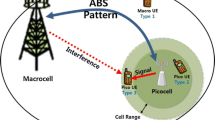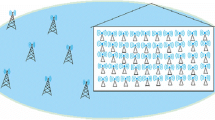Abstract
Femtocells are aimed at providing strong coverage in the indoor area where typical macrocell coverage is very poor. It has hugely attracted network operators and stakeholders mainly due to its simple plug and play operation and low cost. Femtocells operate on a much lower power compared to macrocell and thus provide a number of benefits including energy efficiency and frequent spatial reuse of the spectrum. Femtocells are overlaid on macrocells and designed to co-exist with them sharing the same spectrum pool. However, since they are deployed by the end user, no pre-deployment resource planning is possible. So, interference among the femtocells as well as between femtocells and macrocells remain a major bottleneck for successful operation of femtocell networks. This paper proposes a novel threshold power based admittance and contention free resource allocation for interference mitigation in cognitive femtocell networks. In our proposed scheme, a Femtocell Access Point with Cognitive radio capability known as Cognitive Femtocells (CF), sets a threshold value on the mutual interference between itself and a close by macrocell user equipment (MUE). To mitigate cross-tier interference, a CF classifies MUEs with higher than threshold interference value as Undesirable MUEs (UMUEs) and subsequently admits it as one of its user equipment. MUEs with lower than threshold interference values are classified as Desirable MUEs (DMUEs). To mitigate co-tier interference, proposed scheme introduces a scheduling engine which employs matching policy attributes and assigns resource blocks (RBs) of unique DMUEs to CFs to avoid any possible contention problems, thus providing improved co-tier interference. System level simulations have been performed to demonstrate effectiveness of scheme and significant performance improvement in terms of SINR, throughput and spectrum efficiency.










Similar content being viewed by others
References
Andrews, J. G., Claussen, H., Dohler, M., Rangan, S., & Reed, M. C. (2012). Femtocells: Past, present, and future. IEEE Journal on Selected Areas in Communications, 30(3), 497–508.
Li, Y. Y., & Sousa, E. S. (2012). “Cognitive femtocell: A cost-effective approach towards 4G autonomous infrastructure networks. Wireless Personal Communications, 64(1), 65–78.
Zhang, Q., Feng, Z., & Li, W. (2015). Coverage self-optimization for randomly deployed femtocell networks. Wireless Personal Communications, 82(4), 2481–2504.
Khan, F. H., & Young-June, C. (2014). Adaptive mode configuration in two-tier macro-femtocell networks. IET Communications, 8(7), 1169–1179.
Kim, S. (2013). Multi-objective power control algorithm for femtocell networks. Wireless Personal Communications, 75(4), 2281–2288.
Kpojime, H. O., & Safdar, G. A. (2014). Efficacy of coverage radius-based power control scheme for interference mitigation in femtocells. IET Electronics Letters, 50(8), 639–641.
Razavi, R., Ho, L., Claussen, H., & Lopez-Perez, D. (2015). Improving small-cell performance through switched multielement antenna systems in heterogeneous networks. IEEE Transaction on Vehicular Technology, 64(7), 3140–3151.
Park, S., Seo, W., Kim, Y., Lim, S., & Hong, D. (2010). Beam subset selection strategy for interference reduction in two-tier femtocell networks. IEEE Transactions on Wireless Communications, 9(11), 3440–3449.
Torregoza, J. P. M., Enkhbat, R., & Hwang, W. J. (2010). Joint power control, base station assignment, and channel assignment in cognitive femtocell networks. EURASIP Journal on Wireless Communications and Networking, 2010, 285714.
Cheng, S. M., Lien, S. Y., Chu, F. S., & Chen, K. C. (2011). On exploiting cognitive radio to mitigate interference in macro/femto heterogeneous networks. IEEE Wireless Communications, 18(3), 40–47.
Kpojime, H. O., & Safdar, G. A. (2015). Interference mitigation in cognitive-radio-based femtocells. IEEE Communications Surveys & Tutorials, 17(3), 1511–1534.
Sahin, M. E., Guvenc, I., Jeong, M., & Arslan, H. (2009). Handling CCI and ICI in OFDMA femtocell networks through frequency scheduling. IEEE Transactions on Consumer Electronics, 55(4), 1936–1944.
Wang, W., Yu, G., & Huang, A. (2013). Cognitive radio enhanced interference coordination for femtocell networks. IEEE Communications Magazine, 51(6), 37–43.
Chang, C.-W. (2012). An interference-avoidance code assignment strategy for the hierarchical two-dimensional-spread MC-DS-CDMA system: A prototype of cognitive radio femtocell system. IEEE Transactions on Vehicular Technology, 61(1), 166–184.
Li, L., Xu, C., & Tao, M. (2012). Resource allocation in open access OFDMA femtocell networks. IEEE Wireless Communications Letters, 1(6), 625–628.
Huang, L., Zhu, G., & Du, X. (2013). Cognitive femtocell networks: an opportunistic spectrum access for future indoor wireless coverage. Wireless Communications IEEE, 20(2), 44–51.
Zhang, J., & De la Roche, G. (2010). Femtocells: technologies and deployment. New York: Wiley.
3GPP, “Simulation assumptions and parameters for FDD HeNB RF requirements,” R4-092042, TSG-RAN WG4, Meeting 51, 2009.
Gur, G., Bayhan, S., & Alagoz, F. (2010). Cognitive femtocell networks: an overlay architecture for localized dynamic spectrum access [dynamic spectrum management]. IEEE Wireless Communications, 17(4), 62–70.
Author information
Authors and Affiliations
Corresponding author
Rights and permissions
About this article
Cite this article
Safdar, G.A., Tariq, F. & Kpojime, H.O. Threshold Power Based UE Admittance and Contention Free Resource Allocation for Interference Mitigation in Cognitive Femtocells. Wireless Pers Commun 95, 1601–1616 (2017). https://doi.org/10.1007/s11277-016-3870-z
Published:
Issue Date:
DOI: https://doi.org/10.1007/s11277-016-3870-z




